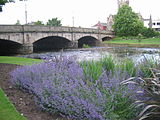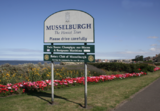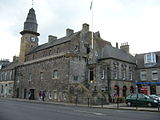- Musselburgh
-
- This article is about Musselburgh in Scotland. For Musselburgh in New Zealand, see Musselburgh, New Zealand
Coordinates: 55°56′36″N 3°02′58″W / 55.94326°N 3.049555°W
Musselburgh Scottish Gaelic: Baile nam Feusgan
 Musselburgh shown within East Lothian
Musselburgh shown within East LothianPopulation 22,212 (2008 census) Council area East Lothian Lieutenancy area East Lothian Country Scotland Sovereign state United Kingdom Post town MUSSELBURGH Postcode district EH21 Dialling code 0131 Police Lothian and Borders Fire Lothian and Borders Ambulance Scottish EU Parliament Scotland UK Parliament East Lothian Scottish Parliament Midlothian North and Musselburgh
LothiansList of places: UK • Scotland • Musselburgh (Gaelic: Baile nam Feusgan[1]) is the largest settlement in East Lothian, Scotland, on the coast of the Firth of Forth, six miles east of Edinburgh city centre.
Contents
History
The name Musselburgh is Old English in origin with mussel referring to the shellfish,[2] and burgh derived from the Old English for 'town'.[3]
Musselburgh was first settled by the Romans in the years following their invasion of Scotland in AD80. They built a fort a little inland from the mouth of the River Esk and bridged the river here. In doing so they established the line of the main eastern approach to Scotland's capital for most of the next two thousand years.
File:Roman Bridge, Musselburgh.jpgThe Auld BrigThe bridge built by the Romans outlasted them by many centuries. It was rebuilt on the original Roman foundations some time before 1300, and in 1597 it was rebuilt again, this time with a third arch added on the east side of the river. The Old Bridge is also known as the Roman Bridge and remains in use today by pedestrians. To its north is the New Bridge, designed by John Rennie the Elder and built in 1806. This in turn was considerably widened in 1925.
The Battle of Pinkie Cleugh was fought south of Musselburgh.
Musselburgh is known as "The Honest Toun", and celebrates this by the annual election of the Honest Lad and Lass. The town motto "Honesty" dates back to 1332, when the Regent of Scotland, Randolph, Earl of Moray, died in the burgh after a long illness during which he was devotedly cared for by its citizens. His successor offered to reward the people for their loyalty but they declined, saying they were only doing their duty. The new regent, the Earl of Mar, was impressed and said they were a set of honest men, hence "Honest Toun".
The town and its population grew considerably throughout the latter half of the 20th Century, with major local authority and private housing developments on both the eastern and western outskirts. Prior to 1975, Musselburgh was in Midlothian, not East Lothian. It became part of the East Lothian District following the Local Government (Scotland) Act 1973 and subsequently East Lothian unitary council area in 1996. There is an anecdote that this caused disappointment within the rest of the county, as, prior to that point, East Lothian had no traffic lights.
Education
Schools include Loretto School, a private boarding school, and Musselburgh Grammar School, the local large comprehensive that is one of the oldest Grammar schools in the country, dating from 1608. Some students also attend St. David's R.C. High School in nearby Dalkeith. Primary Schools include; Campie Primary School, Musselburgh Burgh Primary School, Stoneyhill Primary School, Pinkie St Peter's Primary School, Loretto RC Primary School and Loretto Nippers (Private).
Edinburgh's Queen Margaret University relocated all its schools from Edinburgh to Musselburgh as of 2007. The Queen officially opened the QMU campus in July 2008.
Transportation
Railway
Musselburgh is served by two railway stations Musselburgh railway station in the west of the town situated adjacent to Queen Margaret University which is served by regular First ScotRail services from Edinburgh to North Berwick. It is a relatively new station, opened in 1988. The other station serving the town is Wallyford railway station to the east of the town in the village of Wallyford, opened in 1994, serves the eastern end of the town. The town's original station was situated close to the town centre at the end of a short branch from Newhailes Junction. Passenger services from there ceased in 1964 and the line ultimately closed to all traffic in the early 1970s. It is now a road bypassing the Fisherrow area of the town.
Bus
The town is served by Lothian Buses and First Edinburgh
Roads
The A1 goes round the town and joins up with the A720 Edinburgh City Bypass at the edge of the town before heading into Edinburgh city centre. The A199 goes through the High Street to Edinburgh in the west and to Dunbar to the east. This was originally the A1 road (Great Britain) until the town's bypass was built in the mid-eighties.
Sport
The Musselburgh Silver Arrow is reputed to be the oldest sporting trophy in United Kingdom,[4] and is competed for annually by the Royal Company of Archers. It dates back to at least 1603 [1].
Musselburgh is home to both Musselburgh Racecourse and Musselburgh Links golf course. The links which are a former venue of golf's Open Championship have recently been acknowledged as the oldest continuously played golf course in the world.[5] Musselburgh Athletic F.C. are the town's junior football team playing in the Scottish Junior Football at Olivebank Park to the west of the town. Musselburgh RFC play in the Scottish Premiership 3 at Stoneyhill.
Notable people
See Category:People from Musselburgh
- David Macbeth Moir Physician/writer
- Yvonne Murray Athlete
- Rhona Cameron comedian
- Kenny Miller footballer
- Colin Nish footballer
- Kris Renton footballer
- Jason Holt, Professional footballer
- John McGlynn football manager
- Billy Brown,football coach
- Jim Jefferies football manager
- Willie Ormond footballer and manager
- Steven Black media personality
- John White footballer
- Scott Murray rugby player
- Alexander Carrick sculptor
- Jimmy Martin actor
- Susan Deacon former Member of the Scottish Parliament
- Bill McPhillips, footballer
- According to his autobiography, Sir Harry Lauder's parents lived at Musselburgh after he was born, where Harry's brothers Matthew, John, and Alexander, and a sister, Isabella, were all born. They moved to Derbyshire sometime after April 1881.
Areas
Fisherrow, Inveresk, Levenhall Links, Pinkie, Stoneyhill/Clayknowes/Denholm, Stoneybank, Queen Margaret University Student Village, Monktonhall, Wallyford, Wimpy Estate
Twin towns
 - Champigny-sur-Marne, France.
- Champigny-sur-Marne, France. - Rosignano Marittimo, Italy.
- Rosignano Marittimo, Italy.
Notes
- ^ "Musseburgh". National Place-Names Gazetteer. Ainmean-Àite na h-Alba. http://www.gaelicplacenames.org/databasedetails.php?id=1028. Retrieved 22 October 2011.
- ^ Musselburgh was famous for the mussel beds which grew in the Firth of Forth; after many years of claims that the mussels were unsafe for consumption a movement has been started to re-establish the mussel beds as a commercial venture.
- ^ http://www.gwp.enta.net/scothist.htm#places
- ^ Hugo Arnot, The history of Edinburgh, from the earliest accounts, to the year 1780, Edinburgh, 1816
- ^ "Links play out onto record books". BBC News.co.uk. 2009-03-17. http://news.bbc.co.uk/1/hi/scotland/edinburgh_and_east/7949045.stm. Retrieved 2009-03-18.
See also
- Burgh
- John Muir Way
- List of places in East Lothian
- Musselburgh Cricket Club
- Musselburgh Festival
External links
Aberlady · Athelstaneford · Auldhame & Scoughall · Bolton · Cockenzie and Port Seton · Dirleton · Drem · Dunbar · East Linton · East Saltoun and West Saltoun · Gifford · Gullane · Haddington · Humbie · Innerwick · Kingston · Longniddry · Macmerry · Musselburgh · North Berwick · Oldhamstocks · Ormiston · Pencaitland · Prestonpans · Tranent · Whitekirk and Tyninghame · WallyfordCategories:- Towns in East Lothian
- Musselburgh
Wikimedia Foundation. 2010.










